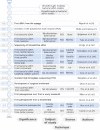The past, present and future of ancient bacterial DNA
- PMID: 32598277
- PMCID: PMC7478633
- DOI: 10.1099/mgen.0.000384
The past, present and future of ancient bacterial DNA
Abstract
Groundbreaking studies conducted in the mid-1980s demonstrated the possibility of sequencing ancient DNA (aDNA), which has allowed us to answer fundamental questions about the human past. Microbiologists were thus given a powerful tool to glimpse directly into inscrutable bacterial history, hitherto inaccessible due to a poor fossil record. Initially plagued by concerns regarding contamination, the field has grown alongside technical progress, with the advent of high-throughput sequencing being a breakthrough in sequence output and authentication. Albeit burdened with challenges unique to the analysis of bacteria, a growing number of viable sources for aDNA has opened multiple avenues of microbial research. Ancient pathogens have been extracted from bones, dental pulp, mummies and historical medical specimens and have answered focal historical questions such as identifying the aetiological agent of the black death as Yersinia pestis. Furthermore, ancient human microbiomes from fossilized faeces, mummies and dental plaque have shown shifts in human commensals through the Neolithic demographic transition and industrial revolution, whereas environmental isolates stemming from permafrost samples have revealed signs of ancient antimicrobial resistance. Culminating in an ever-growing repertoire of ancient genomes, the quickly expanding body of bacterial aDNA studies has also enabled comparisons of ancient genomes to their extant counterparts, illuminating the evolutionary history of bacteria. In this review we summarize the present avenues of research and contextualize them in the past of the field whilst also pointing towards questions still to be answered.
Keywords: ancient bacterial DNA; ancient pathogens; bacterial evolution; paleogenetics; paleomicrobiology.
Conflict of interest statement
The authors declare that there are no conflicts of interest.
Figures



References
Publication types
MeSH terms
Substances
Grants and funding
LinkOut - more resources
Full Text Sources
Miscellaneous

